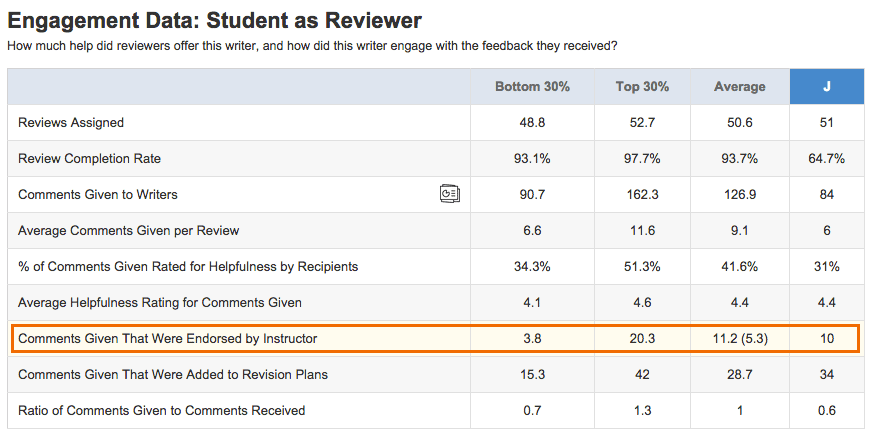In Eli Review, instructors can make endorsements that provide a thumbs-up on helpful comments. Instructors receive a report after every individual review that aggregates reviewer responses and comments. Each comment has a thumbs-up icon and clicking it adds an instructor endorsement to that comment:

While instructors use endorsements for different goals, the endorsement sends a message in two directions:
“This comment says something important; make sure to address it in your revision plan and/or follow the suggestion in the next version.”
“This is a great comment; keep up the good work!”
This brief tutorial addresses why instructors might consider endorsing student feedback, strategies for endorsing comments, and summarizes analytics around endorsement.
Instructors actively facilitate peer learning through task design and the social interactions they sponsor around those tasks. The Community of Inquiry framework theory developed by Cleveland-Innes, Garrison & Vaughan describe this work as establishing a “teaching presence.” The instructor’s presence in peer review, however, is often “ambivalent” (Bedore and O’Sullivan, 2001) because instructors want to give students more authority over their learning despite the fact that instructors retain power such as grading authority. Recognizing the imbalance between peers’ (novice) comments and their own (expert) comments, instructors must make important decisions about how to be present in peer learning.
Endorsements are part of an instructor’s teaching presence in Eli Review. They allow instructors to signal their approval of peer comments and leave a trace of that approval in system for all to see. This visibility helps:

Endorsements function like digital badges that help improve
Endorsements also say “job well done!” to an individual reviewer, recognizing her feedback as helpful or important.
There is no single “correct” endorsement strategy. The endorsement strategy that works is the one instructors explain to students as part of daily teaching practice—as Marianne Stenger explains in the 4th strategy for research-based meaningful feedback. In an online space, teaching presence matters, but what the thumbs up means to students depends on how you describe its value to them in discussion, particularly while modeling the most helpful comments.
We work with instructors who have disparate perspectives:
“I’m going to endorse comments that address the aspect of this assignment that most people struggled with” (and they’d refer to the trait id analytics).
Or, they might say,
“I’m going to endorse comments that are exemplary models of “describe-suggest-evaluate.”
The advantage of endorsing rarely throughout the semester is that it is easier to interpret what the learning analytics mean; in his Tech Writing course, Bill Hart-Davidson endorsed 1% of all comments, which makes it very apparent which reviewers in his class were remarkable. Of his strategy, Bill says:
By being stingy, I was trying to keep them listening to one another and not using me as a filter to tune out unendorsed comments.
Again, the strategy that works is the one instructors explain. An instructor’s presence in student peer comments is not self-explanatory. To benefit from your thumbs-up, students need know why you are/are not endorsing their comments.
Eli Review analytics around endorsed comments provide formative feedback for instructors about one aspect of their teaching presence and can inform mid-term/end-of-course evaluations of students’ engagement with peer learning.
The learning analytics for endorsements help you hold yourself accountable to the strategy for endorsement you’ve selected. Eli’s reports can reveal the percent of endorsed comments for the class, for all reviews, for each review, and per student.
For example, if you are aiming to endorse rarely, but Eli reveals that you are endorsing 25% of the comments, you might want to reassess your goals; either change what you are telling students or change your endorsing behavior.
From the course-level analytics report, there are three ways to check whether your percentage of endorsed comments matches your chosen strategy:
Again, there’s no magic percentage of endorsed comments. Instead, the aim is for a teacher to be present in ways that are consistent with student expectations.
Eli also produces student-level analytics that can help instructors assess students’ work as reviewers and writers. You can access the report for individual students from the course roster or by clicking on any student’s name in Course Analytics reports.

The student analytics about endorsement reveal the following:
This tutorial covers how endorsements might fit into a writing pedagogy. Related resources include: